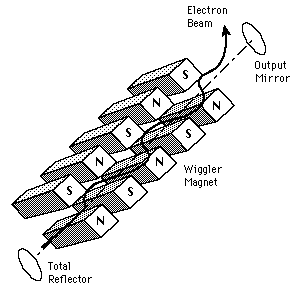Free-Electron Laser
The radiation from a free-electron laser is produced from free electrons which are forced to oscillate in a regular fashion by an applied field. They are therefore more like synchrotron light sources or microwave tubes than like other lasers. They are able to produce highly coherent, collimated radiation over a wide range of frequencies. The magnetic field arrangement which produces the alternating field is commonly called a "wiggler" magnet. |

|
The free-electron laser is a highly tunable device which has been used to generate coherent radiation from 10^-5 to 1 cm in wavelength. In some parts of this range, they are the highest power source. Particularly in the mm wave range, the FELs exceed all other sources in coherent power. FELs involve relativistic electron beams propagating in a vacuum and can be tuned continuously, filling in frequency ranges which are not reachable by other coherent sources.
Applications of free-electron lasers are envisioned in isotope separation, plasma heating for nuclear fusion, long-range, high resolution radar, and particle acceleration in accelerators.
Laser concepts
Laser types
Reference
Electro-Optics Handbook
Pasour, Ch. 8